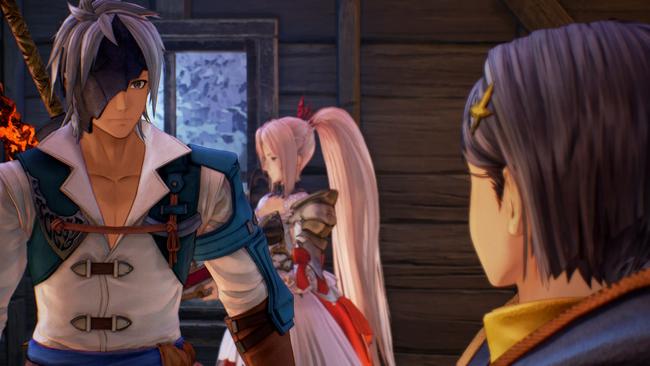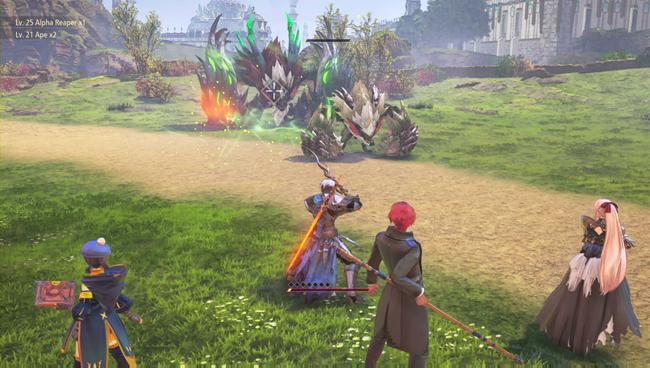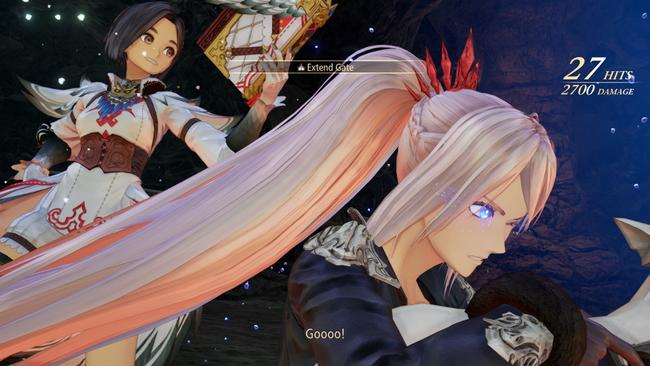
Tales of Arise Review
I vividly remember the summer of 2019, sitting underneath a large circus tent enjoying a local Irish festival, listening to the Gaelic tunes of the band Brothers Crowe, when news hit that a brand new Tales game had been announced. Now, two years later, through the tribulations of the pandemic and dramatic shifts in working practices, Tales of Arise is finally out, and my Tales fix has been satiated.
Tales of Arise welcomes players with depictions of slave labor, abuse, and a mysterious masked individual, all surrounded by fiery plumes of ash and embers. Right from the getgo, it becomes apparent that Tales of Arise will be dealing with some heavy topics.

Taking place in the world of Dahna, a segregated world where its inhabitants - the Dahnans - are lorded over by the Renans, invaders from the foreboding planet & moon floating in the sky. By taking advantage of their far superior technology, the Renans were able to crush and enslave the Dahnans in a war that occurred 300 years prior, now putting them to work as slave laborers to gather a particular resource called Astral Energy. Every ten years, the Renans hold a contest to see which currently ruling lord will succeed the throne and become king or queen of Rena.
This time around, you follow the exploits of Alphen, an amnesiac Dahnan slave who strangely cannot feel pain, as he teams up with an unlikely ally, a Renan woman named Shionne, cursed with spectral thorns that harm any who get close and touch her. Together they will struggle to bring down the system that has enslaved Alphen and his people and crush all the regional Lords who rule over them in an attempt to win the Crown Contest.
Throughout the journey, you will encounter a band of diverse like-minded individuals in traditional Tales series fashion to assist in this seemingly insurmountable task. This includes the fisticuffs brawler Law, the magic-hurling Rinwell, the defensive powerhouse Kisara, and the staff spinning battle wizard, Dohalim, who with Alphen & Shionne create a well-balanced band of unlikely heroes.
I was intrigued by many reveals throughout the story and was always anxious to see what would happen next and keep pressing on. Even as a Tales series veteran, there were several plot twists and surprises that I didn’t see coming or expect. The tone is decidedly darker in Tales of Arise and occasionally more melodramatic than its predecessors. Still, once I started down the road with Alphen and company, I didn’t want to stop!

However, the pacing and some plot threads could have been handled or explored far deeper. The fact that the main male protagonist, Alphen, can’t feel pain and that the main female protagonist, Shionne, causes pain to anyone who touches her was a central point in even the earliest of reveals for Tales of Arise. These facts are regurgitated repeatedly in the first few hours and then seemingly dropped and have no relevance on the plot for many hours afterward. These strange afflictions eventually get explained and fleshed out to a satisfying degree, but the dead zone where it just doesn’t get addressed at all narrative I found odd. It's perhaps a bit trivial, but I would have liked some sort of explanation as to why the enemies and monsters seem to have no problem hitting Shionne up close.
A few other plot points which seem vital at the time fade away and get no real explanation. A particular fruit is an example (leaving this vague to avoid any spoilers). When it comes up, you’re given the impression that this will be crucially important, and for a couple of scenes where it is brought up, it is. However, poof, it’s gone. A handful of situations like this made me beg the question, why include them at all?
When it comes to the cast in a Tales game, I’ve always found the relationships between the characters to be one of the most enjoyable and important aspects of the series. I have fond memories of the close friendship between Lloyd, Genis, & Colette. the brother-like bond of Luke & Guy, or the simmering rivalry of Reid and Keele. Tales of Arise lacks that special pair or trio of characters that have either a deep-rooted history or charismatic bond that carries throughout the game's storyline. Only the last two you encounter have any sort of history with one another, but the big plot machine was well along its path by that point.
In place of established character connections are circumstances & people deciding to upend hundreds of years of a flawed societal imbalance with folks they met a week ago. On the one hand, you can see these terse relationships blossom over the course of the adventure, but it still left me exasperated for the first half by many of the reactions and interactions that this band of misfits shared.
None of that should be taken that I don’t like the characters. While they don’t beat out my favorite Tales cast of characters, I still found most to be endearing. My personal favorite was the staff-wielding Dohalim, who perfectly exuded that awkwardness of someone who may be out of touch with much of reality, but still is out to better themselves and others. I found his complex background and view on the issues plaguing Dahna to be some of the most interesting character moments in the game. The fact that he also had a tendency to be overdramatic and speak in poems made for some great times too.
The real rockstars of Tales of Arise, and what blew me away most, are undoubtedly the visuals and the combat, which I feel will be talked about long after the game’s release. Tales of Arise made the shift from its seemingly existing ancient engine to Unreal Engine 4, and while there were growing pains along the way, the sweeping vistas, dynamic effects, and dramatic lighting prove that the decision was a good one. The character models & animation are also fantastic and fit within the world perfectly. To say that Tales of Arise is the best-looking title in the series is almost a gross understatement. Tales has never looked close to this good, at least in 3D entries.

The lands you will visit, from the billowing plumes of fire and rocks of Calaglia to the verdant planes of Menancia and more, all look breathtaking. Whenever I would head to a new region, I found myself giddy with excitement as each area, be it town, city, or sprawling landscape, would be filled with personality and goodies to track down. You don't have to worry about endlessly copy-pasted fields this time around. Charting all of the new locations for its ore deposits, resources, chests, or the ever-illusive Owls, was a joy, and I loved doing it.
The process of hunting all these things down is made even better with how well Tales of Arise handles keeping track of everything, with your map constantly getting updated with icons denoting locations of these resources, quest markers, owl locations, and more. And if that wasn’t enough, at any time, you can go into the menu and look at your records that conveniently keep track of how many chests, owls, quests, elite monsters, and items you have found, along with how many you have left to go.
Moving on next to the combat, boy-o-boy has Tales of Arise knocked it out of the park here. While some fans of the series criticized it, Arise utilizes a refined and evolved version of the Soul Gauge system in its direct predecessor, Tales of Berseria. In place of your standard TP of yesteryears, offensive-based artes are tied instead to charges that refill during combat, with three of your face buttons have distinct artes assigned to each. In contrast, healing and support artes are tied to a new resource called “Cure Points” that you can hear all about here in our deep-dive of the mechanic.
For the naysayers of Berseria’s combat, I am here to relieve your anguish and fears and promise that Tales of Arise’s combat is vastly superior and is all-around a more fun and rewarding experience. A lot of work has gone into making the combat both rewarding and strategic, by encouraging not just sheer damage output but also coming up with long combo strings and taking advantage of your party members’ unique abilities.

Each of your characters has a special ability called a "Boost Attack” that can be used in battle to down and render an enemy defenseless for a few seconds. These include Alphen slamming down his Blazing Sword onto an enemy, Rinwell’s arte canceling boost that will stop any enemy that is mid-casting a spell, or Law’s guard-shattering fist. These situational actions will force you to really watch and analyze your enemy’s movements and tells that you can use to exploit. It makes every character valuable, even when they are not in the battle party, because Boosts can be used by reserve members as well.
Taking a page from Tales of Graces’ playbook, you will be rewarded by perfectly timing your dodges or blocks too. Should you dodge out of the way right before an attack hits, you can quickly follow up with a teleporting counterattack that will instantly take you right up on whichever foe you are currently locked on to. These counter-attacks will often break an opponent’s guard, causing them to be easily combo’d and knocked into the sky.
As you build up a combo on a target, you will slowly fill a special bar. Once this bar is full, your party members are able to team up to perform visually impressive and instant-kill team-up attacks that will kill an enemy, regardless of their health. This Strike Attack feature really shakes up more difficult fights, as it changes your focus from trying to outlive an opponent by dishing out damage to instead figuring out ways to extend your combos so that you can trigger these special attacks. I found that this shift in my focus and thought process during difficult fights added a considerable amount of strategy and planning that other Tales games slightly lacked, and Tales of Arise’s combat is far better off for it.

The game's combat does take a while to grow into form, however. At the start, you can set three artes for use while you are on the ground and three more that can be used while in the air. Later (far too much later in my opinion) you gain the ability to set three more artes to both. You also get access to more boosts of course as you add more and more characters to the party. Everything finally comes together roughly 10-15 hours into the game.
While it’s clear that a lot of effort was put into making the overall presentation and feel of Tales of Arise, that doesn’t mean some aspects didn’t fall through the cracks. There are various instances where the name of the arte doesn’t match up with what is spoken, such as Shionne and Dohalim’s “Resurrection” arte being called out as “Resuscitation” by the voice actors, or Alphen’s “Scarlet Outburst” mystic arte being called out as “Scarlet Inferno” just as a couple of examples. This mixup extends to some dialogue boxes as well, where in one situation, the text box that pops up was reused from a previous encounter which is the opposite gender than the NPC you are interacting with. I also noticed a handful of other typos throughout the text. Far from experience-ruining, but errors like these are prevalent enough to make note of.
Monster variation is another aspect that could have afforded more time and focus on. You will be seeing a lot, and I mean a lot, of palette-swapped monsters during your playthrough. You will be facing against most of the same varieties of enemy models from the starting area up through even the final and post-game dungeons. The only differences will be their colors, element affinity, and health. This issue extends even with some bosses, as once you fight them as a boss, given some time, you will see many of them again simply roaming around the landscapes or dungeons just with a new coat of paint, lessening much of the impact they had as a boss. And since holy bottles don’t exist and you will pull aggro for every enemy mob, regardless of how vastly stronger than them you are, you will have to face lots and lots of them. Even with as good as the combat, this can make encounters tiresome and a bit of a chore at times.
After rolling credits, I came away from my 65-hour Tales of Arise experience smiling and reflecting back on the latest adventure in one of my all-time favorite JRPG franchises. While not without its bruises, Tales of Arise overcame many struggles during its development and came out a winner. It’s a breathtaking visual splendor that anime-inspired RPGs will be compared against for years to come and sets a grand new precedent for the franchise. The story left me in suspense, and by the end, I had grown to care for my characters and the tribulations they have soldiered through.
Tales of Arise is an excellent introduction to the series for new players and a fantastic entry for old fans. If this is any indication, the franchise is in for a bright future. Hopefully, it won’t be another five years before the next one.